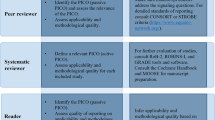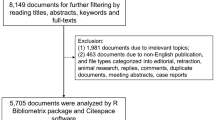Abstract
Background
Scientific research is an essential aspect in the ongoing development of medical education and improved patient care. Dissemination of findings is a pivotal goal of any health research study. The number of citations that a published article receives is reflective of the importance that paper has on clinical practice. To date, it is unknown which journals are most frequently cited as influencing the management of pelvic trauma.
Methods
The aim of this study was to identify the top 50 publications relating to the management of pelvic trauma. The database of the Science Citation Index of the Institute for Scientific Information (1945 to 2016) was reviewed to identify the 50 papers most commonly cited.
Results
A total of 1535 papers were included. Of these, 31 papers were cited over 100 times with the top 50 cited 69 times or more. The top 50 were subjected to further analysis to identify the authors and institutions involved. The majority of these publications originated in the USA, followed by Canada. The most cited paper is “pelvic ring fractures—should they be fixed”, published by Tile in 1988.
Conclusion
We have identified and analysed the publications that have contributed most to the assessment and management of pelvic trauma over the past 50 years. We have also identified the researchers and institutions which have most influenced the evidence-based approach currently employed in the management of pelvic trauma.
Similar content being viewed by others
References
Girard N (2009) Dissemination of findings: the final step of investigation. Periop Nurse Clin 4:297–306
Santisteban D, Vega RR, Suarez-Morales L (2006) Utilizing dissemination findings to help understand and bridge the research and practice gap in the treatment of substance abuse in Hispanic populations. Drug Alcohol Depend 84(suppl. 1):594–601
Kelly JC, Glynn RW, O’Briain DE, Felle P, McCabe JP (2010) The 100 classic papers of orthopaedic surgery: a bibliometric analysis. J Bone Joint Surg Br 92:1338–1343
Jones AW (2003) Impact factors of forensic science and toxicology journals: what do the numbers really mean? Forensic Sci Int 133:1–8
Dunikowski LG, Freeman TR (2016) Impact of family medicine research: bibliometrics and beyond. Can Fam Physician 62:266–268
Castro RC (2006) Journals in surgery and gastroenterology: indexing in databases and bibliometric indicators. Acta Cir Bras 21:122–132
Glynn RW, Scutaru C, Kerin MJ, Sweeney KJ (2010) Breast cancer research output, 1945-2008: a bibliometric and density-equalizing analysis. Breast Cancer Res 12:R108
Hirsch JE (2005) An index to quantify an individual’s scientific research output. Proc Natl Acad Sci U S A 102:16569–16572
McVeigh ME, Mann SJ (2009) The journal impact factor denominator: defining citable (counted) items. JAMA 302:1107–1109
Garfield E (1998) The impact factor and its rightful use. Anaesthesist 47:439–440
Garfield E (1999) Journal impact factor: a brief review. Can Med Assoc J 161:979–980
Saha S, Saint S, Christakis DA (2003) Impact factor: a valid measure of journal quality? J Med Libr Assoc 91:42–46
Paladugu R, Schein M, Gardezi S, Wise L (2002) One hundred citation classics in general surgical journals. World J Surg 26:1099–1105
Margolies MN, Ring EJ, Waltman AC, Kerr WS Jr, Baum S (1972) Arteriography in the management of hemorrhage from pelvic fractures. N Engl J Med 287:317–321
Cothren C, Osborn PM, Moore EE, Morgan SJ, Johnson JL, Smith WR (2007) Preperitoneal pelvic packing for hemodynamically unstable pelvic fractures: a paradigm shift. J Trauma 62:834–842
Koraitim MM (1999 May) Pelvic fracture urethral injuries: the unresolved controversy. J Urol 161(5):1433–1441
Koraitim MM, Marzouk ME, Atta MA, Orabi SS (1996) Risk factors and mechanism of urethral injury in pelvic fractures. Br J Urol 77:876–880
Flint L, Babikian G, Anders M, Rodriguez J, Steinberg S (1990) Definitive control of mortality from severe pelvic fracture. Ann Surg 211:703–707
Flint LM Jr, Brown A, Richardson JD, Polk HC (1979) Definitive control of bleeding from severe pelvic fractures. Ann Surg 189(6):709–716
Kulkarni AV, Busse JW, Shams I (2007) Characteristics associated with citation rate of the medical literature. PLoS One 2:e403. https://doi.org/10.1371/journal.pone.0000403
Tile M (1988) Pelvic ring fractures: should they be fixed? J Bone Joint Surg Br 70:1–12
Dalal SA, Burgess AR, Siegel JH et al (1989) Pelvic fracture in multiple trauma: classification by mechanism is key to pattern of organ injury, resuscitative requirements, and outcome. J Trauma 29:981–1002
Young JW, Burgess AR, Brumback RJ, Poka A (1986) Pelvic fractures: value of plain radiography in early assessment and management. Radiology 160:445–451
Author information
Authors and Affiliations
Corresponding author
Ethics declarations
No consent was required for this research.
There were no human or animal participants in this study.
Conflict of interest
The authors declare that they have no conflict of interest.
Rights and permissions
About this article
Cite this article
White-Gibson, A., O’Neill, B., Cooper, D. et al. Levels of evidence in pelvic trauma: a bibliometric analysis of the top 50 cited papers. Ir J Med Sci 188, 155–159 (2019). https://doi.org/10.1007/s11845-018-1818-x
Received:
Accepted:
Published:
Issue Date:
DOI: https://doi.org/10.1007/s11845-018-1818-x




